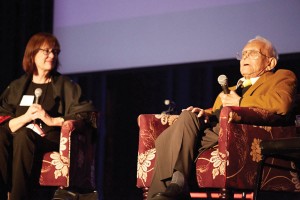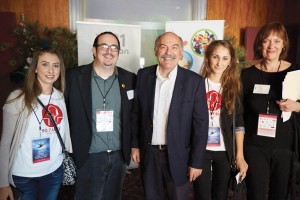Katrina Bissett
Staff Writer

Husain. Martin was in Fresno for the screening of “The Cut.”
Photo: Keith Seaman Photography
“All the stars were against Armenia to survive,” stated screenwriter Mardik Martin. But Armenians did survive, and they are now telling their story. Armenian-themed films are beginning to gain popularity, and Fresno has now hosted the screening of two such films this year.
A special screening of The Cut, an independent film centered on the life of a survivor of the Armenian Genocide, was featured in the Fresno Film Festival presented by Fresno Filmworks on Saturday, November 14, and was cosponsored by the Armenian Studies Program.
“It was very important having The Cut as part of the Fresno Film Festival because it was a way to bring the story of the Armenians to a larger audience. It was an opportunity for people to watch a film about the Genocide that also tells an emotional story that people can connect with,” stated Professor Barlow Der Mugrdechian.
Jefferson Beavers, President of Fresno Filmworks, believes that the film is important not only to the Armenian community, but to the community as a whole, to acknowledge the tragic events that took place. It is part of the Fresno Filmworks’ mission “to expose people to the stories that they’re not going to see anywhere else.”

Photo: Keith Seaman Photography
Directed and written by Fatih Akin, with screenwriter Mardik Martin (known for his work in Raging Bull and New York, New York), the film provided a vivid retelling of the events of the Genocide, highlighting the horrors the Armenians were forced to face and the continuing struggle to regain lost hope in the wake of overwhelming violence.
The film stars Tahar Rahim as the mute Nazaret Manoogian, a father searching for his twin daughters after learning that they survived the Genocide. Akin and Martin withheld no punches on the subject of Armenian suffering, refusing to sugarcoat this black segment of history. In an audience Q & A after the showing, Martin stated, “We tried to tell the truth, and that’s all it is.”
In The Cut, Manoogian is taken from his hometown of Mardin in 1915. This is just the beginning of what would come to be called the Armenian Genocide. Manoogian survives a mass killing in the desert and eventually learns that his children survived as well. He embarks on an arduous trans-continental journey to find his daughters, defying all obstacles. Rahim gave a moving performance as Manoogian, managing to emote clearly and soulfully without the medium of speech. He used his entire body to illustrate Manoogian’s inner turmoil, from utter despair to the scorching rage of a man abandoned by God in the face of suffering. His portrayal of a man overcoming such a difficult handicap is genuinely touching, and it was evident that the audience felt so.
The settings for the film varied drastically, from the Middle Eastern desert to the North American prairies. The desolation and loneliness of the land mirrored the events of the film, lending it authenticity.

Composer Alexander Hacke’s original film score was truly outstanding. Following a theme of simplicity, the soundtrack forced the viewer to focus solely on the emptiness of Manoogian’s experiences. The main themes that were used throughout the film use modern instrumentation but pay homage to traditional Armenian music, with haunting melody lines and underlying drones. The modern edge of the soundtrack drew the audience in.
Overall, the film was a cinematic success. It had talented actors, stunning scenery, haunting music, and a beautiful story. It is fair to say that Akin’s vision for an accurate retelling of history was realized. It is hoped that this film, and others like it, will lead to wider acknowledgment of the Genocide.
 Hye Sharzhoom Armenian Action
Hye Sharzhoom Armenian Action